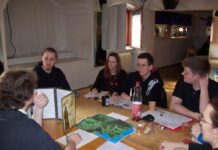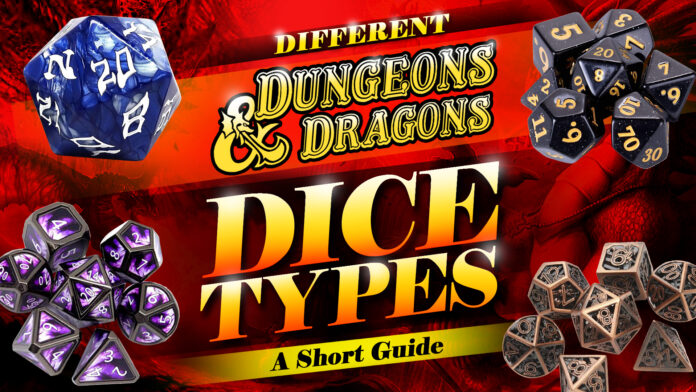
Whether you play the game or not, chances are you have most likely heard of Dungeons and Dragons, a very popular RPG game now. This staple American game has been on store shelves since the 1970s, but what’s the real history of the game with all the crazy dice?
Contents of this Page
The Types of Dice Set for RPG DnD Games
Typically, the dice for the RPG DnD game is played with seven different sets of dice, which has an average size of 16mm or 0.63 inch. There is the 20 sided die, also known as the D20, the 12-sided or D12, the 10-sided die or D10, the 8-sided die or D8, the six-sided die or D6, and finally the 4-sided die or D4. Most versions of the game include one set of each die typically put on trays to keep them in one place. The exception to this is the D10. Used for percentage rolls, most games include two sets of this particular die.
Despite having different sizes, they typically use one of the most common materials for making dice. This includes plastic, Polyhedral dice, and more.
The D20
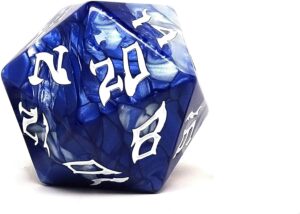
The D20 sided dice is the most used die-out of the whole set, which explains you can find plenty of varying materials, from Polyhedral dice to metal, among others. If you are engaged in a battle, it determines who strikes the first blow and how efficient that blow is. If you are going up against a player and he rolls a 9 but you roll a 13, you have the initial advantage over that player. In a simplified way, if the player you roll against has a protection level of 17, you must roll higher than 17 to deal any damage to him. If you don’t roll 17, other dies can add levels to your attack, but this will be explained later. This is actually how the other die comes into play during the game.
The D12
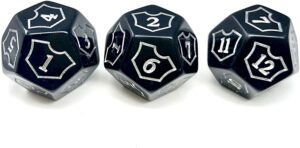
The job of the D12 is to almost exclusively determine the damage dealt during a battle. During the game, you have “life points”. Once your life points hit zero, your character in the game is dead. You roll the D20, and the D12 determines the level of damage done by the attack determined by the prior roll of the D20. If your opponent only has 7 points left and you roll an 8 with the D12, you will take him out of the game.
The D10
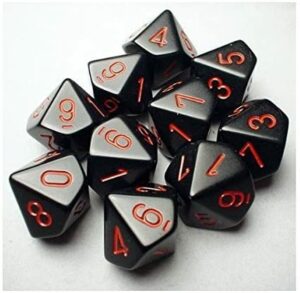
The D10 is very similar to the D12. Remember in the beginning when we said there were two D10’s used? These two dice will make up a percentage point. Let’s say you are playing the game and you have to cross a river. You roll a 5 and a 4. You have a 56% chance of surviving. Other attributes factor into your percentage. Let’s say after these factors you are down to a 29% chance of survival. You roll a second turn. If you roll higher than 29%, you would survive your trip across the river. If you fall into the river it starts a whole new turn. Other attributes determine whether or not you survive a spill into the river. This would fall on a subsequent roll of the dice to determine your fate on a new turn.
The D8
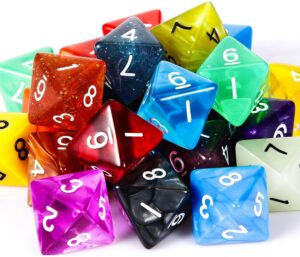
The D8 is used quite often because it decides the damage factor done with weapons that can be held in one hand, such as a sword. The other hand can hold a shield. This is the most common type of combat in the game. Weapons that do between 1 and 8 points worth of damage will call on a roll of the D8 die.
The D6
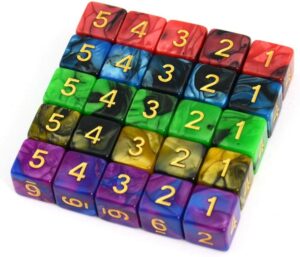
The D6 is the die that is most common to outsiders who don’t play the game. It’s shaped just like the die used in common board games. However, in DnD, there are numbers on the die and not dots. The D6 determines the damage done by different spells and weapons other than those decided on by the D8.
The D4
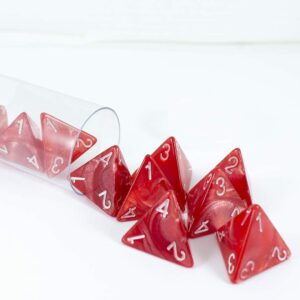
The D4 determines the damage done by the most minute weapons in the game. Now you are most likely seeing a pattern emerge. The result is determined by the number on the bottom edge of the die you are using. There is a number on each of the three sides of the die. The number determined along the bottom edge is the only one that appears right-side-up when you hold the die at an angle.
Throwing Tips from Experienced Players
Have you noticed how some RPG players are just so good at the game? Well, the way they throw the dice actually played a huge part in it.
How do players get an edge in Dungeons and Dragons? The answer to that question is easy. You get your dice-rolling technique perfected. This is the most important dynamic of the game. You’re going to want to master your throw. Luckily we have some tips for you to live by.
What is a dice strip you ask? It’s just what it sounds like. Use a piece of cardboard to cut out a long, thin strip. Make sure it’s not paper-thin, you want a little bit of depth to it. During times of the game where dice rolling is hot and heavy, you can roll the dice against the strip and label where each die landed. This avoids any confusion or lag in gameplay. In the long run, this can avoid disputes as well.
Have you ever seen baseball players get really into their throw? We are talking about pitchers, specifically. Some pitchers use their wind-up to intimidate batters or hide their pitch and confuse a potential hitter. You can use this same technique when you roll. Don’t be afraid to use your arms, legs, hands, and head simultaneously. Leave it all in the field and don’t pull any punches. These techniques can seriously intimidate your opponent.
This is a lifelong question that begs to be settled. There are two kinds of dice rollers in this world. There is the open-handed roller and the closed-handed roller. Keeping the closed hand may add a layer of mystery but it can also confuse.
Using an open hand displays a form of confidence. It also leads to transparency between you and your opponent. Using an open-handed style can save you from being accused of shady gameplay.
Making Your Own Dice
Designing and creating your own dice can be a very rewarding way to bring your own signature to the game. The process is fairly easy and requires very little material. Since you’ll be pouring the design, you can virtually use any items you want to decorate the dice sets.
1. Materials You’ll Need
- Silicone making material
- Casting resin
- Type of die you want to create (you’ll use this for your mold)
- Spoon for stirring
- Toothpick
- Disposable cup
- Material/items you want to fill and decorate your die with
2. Mold
Using whichever silicone mold package you decided on, begin pouring per the directions that came with the kit. Stir with your spoon.
Mix a fresh batch of a silicone mold. Pour a little bit of the new batch on top of the first batch you made. Place the die you want to cast into the middle of the cup with the two silicone molds. Make sure it is face up. Press down on it so it makes contact with the dry silicone from the first batch. Fill the cup around the die with silicone, but stop at the edge of the die. Set this aside to dry.
3. Removing the Die
Once the silicone is dry, carefully remove the dice from your molds. You can make several at a time. This method is perfect for Dungeons and Dragons considering you use several different types of dice.
4. Making the Resin
Mix your batch of resin and stir it with your toothpick or disposable stick.
Pop the new dice out of their molds. Look at all the faces because the top side will be numbered, number one. If the top has shrunk upon removing them, you can mix up another batch of resin to add to the form.
6. Personalization
You can use a sharpie to draw on pieces of clear plastic and embed this beneath the resin to add a personal touch.
The complete drying process will take a couple of hours. Keep an eye on the die during this time to make sure no edges end up bubbling or bowing out, causing a warped shape.
Final Product
You can use a permanent marker to color the number of each side of the die. There may be some slight imperfections but if you were careful these should be minimal. These imperfections just add character.
Special Edition D&D Dice for Collectors
For players who aren’t as creative, there are many specialty websites and stores that sell personalized and custom dice for the game. A special edition dice set is the Kraken Dice, which comes in all varieties and are made of a wide array of different materials.
A simple search online can turn up many of these specialty online stores. Dungeons and Dragons have become so popular that stores selling handmade dice are plentiful.
Keeping Your Dice Clean
Caring for your dice can consist of several different methods depending on what type of dice you own.
Another idea is to use an old ring or a classic jewelry box if you want to store each die separately. This is a cool idea for gamers who have a more intricate die collection that needs more care.
Metal Dice
You can store metal dice in the same fashion as the plastic-type. Any dry, soft container or bags that keep them out of the elements will do just fine. What you are looking to avoid is extreme heat and moisture. These two elements will destroy your dice faster than anything. Heat and moisture both can cause warping to your dice and problems with the cosmetics and finish.
The cleaning process is quite similar to plastic when it comes to the metal version. One of the biggest differences is in the type of soap you use. If you have metal dice, you’re going to want to use hand soap as opposed to dish soap. Hand soap is more gentle, so there are fewer chances of damage to the dice. Be sure to use a non-abrasive cleaning towel and always wipe dry when you are done cleaning.
Surfaces To Roll On
There are many different options when it comes to surfaces to roll dice on. You have to consider several factors when making your decision.
Seriously, if the dice are that special to you, rolling on carpet or even a turf-like surface may be your best option.
History of the Game
In 1967 The International Federation of Wargaming is founded by Gary Gygax to give wargame fans a platform to exchange ideas and different gaming designs they have.
By the time 1968 rolled around, the Lake Geneva Wargames Convention was planned by Gygax. Hosted in the Horticultural Hall of his hometown in Lake Geneva, Wisconsin, this was an official IFW event.
In 2013 the original 1974 version is reprinted and released in its original packaging. Since its origin, Dungeons and Dragons have sold millions of copies and have been adapted into many different versions known as “dimensions”.


